“There are in fact 100 billion galaxies, each of which contain something like a 100 billion stars. Think of how many stars, and planets, and kinds of life there may be in this vast and awesome universe.” -Carl Sagan
And at long last, Carl Sagan's estimates are finally out of date. It's not ~100 billion galaxies, but a number more like two trillion, and at last we know! If you wanted to know what the topic of this month's Starts With A Bang podcast was going to be, there's your answer! Look for it sometime over the next two weeks. Of course, none of that has changed what we write about here at Starts With A Bang! If you missed anything this past week, catch up now:
- How can we see all the way back to the Big Bang? (for Ask Ethan),
- Galaxies found close together show signs of impending doom (for Mostly Mute Monday),
- What's so special about special relativity?,
- Where does our arrow of time come from?,
- How far away are the stars? Scientists still don't know, and
- Hubble's latest breakthrough reveals trillions of unknown galaxies in the Universe.
Also, I was on my local news channel again, talking about Hubble, Mars missions and -- ever so briefly -- my new upcoming book that I'm more than halfway through writing!
It's been a great last week, but you need to have your say, too! There weren't a lot of comments in number this week, so we'll just have to go into more detail than normal with the good ones that we have. Without further ado, let's take a dive into our comments of the week!
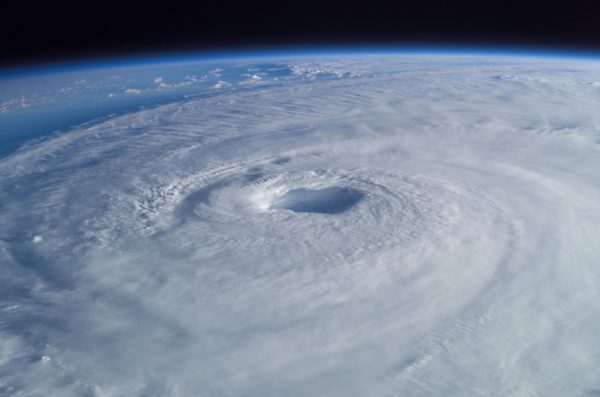 Hurricane Isabel, as viewed from the International Space Station in 2003, shows the characteristic eye, eyewall, arms and rain bands all commonly associated with hurricanes. Image credit: Mike Trenchard, Earth Sciences & Image Analysis Laboratory, Johnson Space Center.
Hurricane Isabel, as viewed from the International Space Station in 2003, shows the characteristic eye, eyewall, arms and rain bands all commonly associated with hurricanes. Image credit: Mike Trenchard, Earth Sciences & Image Analysis Laboratory, Johnson Space Center.
From Anonymous Coward on historical hurricanes: "The world ocean Panthalassa as it existed back in the Devonian seems like it was almost as big as the Atlantic and Pacific oceans put together, and I’d think a storm moving across such a huge expanse of warm water completely uninterrupted by land masses would gain strength like no storm possible today, until it hit the coast of Gondwana or Euramerica."
It's possible that storms would have had the potential to reach even greater strengths hundreds of millions of years ago than they do today. There are a few factors that contribute, including:
- increased air and ocean temperatures over today,
- longer oceanic tracts for the storms to traverse and gain strength over,
- and slightly larger wind speeds in general back then.
A.C. would like to focus on the second.
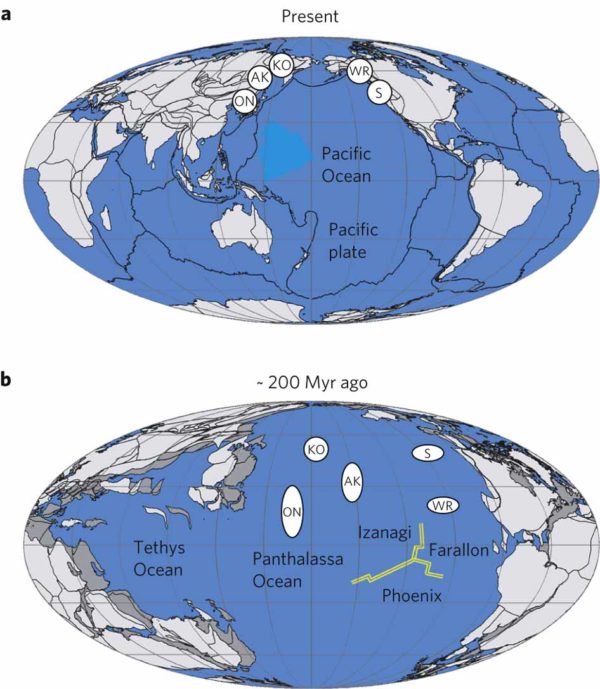 The Earth today vs. the Earth a long time ago. Image credit: D. G. van der Meer, T. H. Torsvik, W. Spakman, D. J. J. van Hinsbergen & M. L. Amaru, Nature Geoscience 5, 215–219 (2012).
The Earth today vs. the Earth a long time ago. Image credit: D. G. van der Meer, T. H. Torsvik, W. Spakman, D. J. J. van Hinsbergen & M. L. Amaru, Nature Geoscience 5, 215–219 (2012).
That's actually the most difficult of the three things to predict. Take the hurricanes that strike the United States these days. Where do they form? Mostly in the Caribbean, most of the rest in the Atlantic, and only a few off the western coast of Africa. The last category is where the deadliest, strongest storms tend to originate, but for some reason very few storms, number-wise, form there. In addition, just because the conditions are met for "how hurricanes form" in general doesn't mean that hurricanes are actually going to form where you want. For example, here's where hurricanes are seen to actually occur on Earth today.
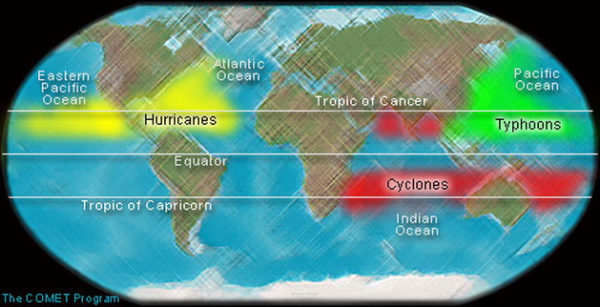 The locations of hurricanes, typhoons and cyclones. Image credit: The COMET program from The University Corporation for Atmospheric Research.
The locations of hurricanes, typhoons and cyclones. Image credit: The COMET program from The University Corporation for Atmospheric Research.
Although there's a longer track for these storms to take in a world that has more contiguous, equatorial oceanic area, will that matter? It might, but as far as I know, it may not as well.
But warmer temperatures and faster Earth rotation back then should have resulted in stronger storms, even if all the other conditions were the same. But by how much? I don't think anyone quite knows.
 The hot Big Bang resulted from the end of cosmological inflation. But that still required the existence of space, time, and a large zero-point energy. Where did all of *that* come from? Image credit: Bock et al. (2006, astro-ph/0604101); modifications by E. Siegel.
The hot Big Bang resulted from the end of cosmological inflation. But that still required the existence of space, time, and a large zero-point energy. Where did all of *that* come from? Image credit: Bock et al. (2006, astro-ph/0604101); modifications by E. Siegel.
From Naked Bunny with a Whip on photons and the Big Bang: "One of the tricky aspects of discussing cosmology is getting past the idea that the universe is a sphere and that the Big Bang happened at the center of the sphere. If that were the case, then the CMB would have already zipped past us as we glide away from the center more slowly than light. But the large scale structure of the universe isn’t so intuitive, and that’s a big stumbling block that comes up all the time."
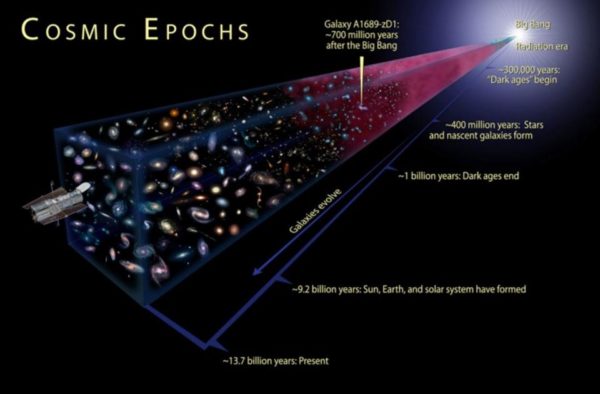 Even though the light from the Big Bang fades in wavelength, energy and density over time, it's still present at all times; we just need to know how to look for it. Image credit: NASA, ESA, and A. Feild (STScI).
Even though the light from the Big Bang fades in wavelength, energy and density over time, it's still present at all times; we just need to know how to look for it. Image credit: NASA, ESA, and A. Feild (STScI).
We're used to looking "out" and seeing things at a variety of distances and thinking that's what they really are. We don't stop and think about what someone at one of those other points would see, because we've never been to another location on a cosmic scale and taken any data. It's easier to get people to accept scientific measurements from places that they could, themselves, go, as other humans have done, than to accept something based on an assumption, no matter how good that assumption actually is.
But yes, this view we have of the Big Bang's leftover glow (or the imperfections in it) are a direct result of the Big Bang occurring everywhere at once some 13.8 billion years ago. After a 13.8 billion year journey and being redshifted by more than a factor of 1000, those photons hit our detectors and show up as the CMB. From our perspective, we look out and we do see a sphere, but from any other location in the Universe, they'd see something very similar, different only in the details of the fluctuations, not in the statistics. If we could wait millions of years to watch the fluctuations change, perhaps people would begin to understand that better.
 A system set up in the initial conditions on the left and let to evolve will become the system on the right spontaneously, gaining entropy in the process. Image credit: Wikimedia Commons users Htkym and Dhollm, under a c.c.-by-2.5 license.
A system set up in the initial conditions on the left and let to evolve will become the system on the right spontaneously, gaining entropy in the process. Image credit: Wikimedia Commons users Htkym and Dhollm, under a c.c.-by-2.5 license.
From Carl on Maxwell's demon: “This idea became known as Maxwell’s demon, and it enables you to decrease the energy of the system after all!”
Seems like it should be “entropy”, not “energy”."
This was a typo. But to clarify, if you take a system of particles, their individual kinetic energies and the distribution of those energies determine the temperature of the system. In general, slow-moving particles with low kinetic energies represent "cold" systems and fast-moving ones with high kinetic energies represent "hot" systems. There is a connection between energy and entropy in that a hot system and a cold system, separately, can do work and can be converted into an engine, and hence is a low-entropy system. On the other hand, two systems with the same total energy but where both systems are the same, lukewarm temperature can do no work and will be a 0% efficient engine, and is therefore a high-entropy system.
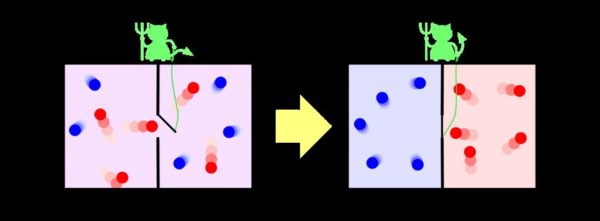 A representation of Maxwell’s demon, which can sort particles according to their energy on either side of a box. Image credit: Wikimedia Commons user Htkym, under a c.c.a.-s.a.-3.0 license.
A representation of Maxwell’s demon, which can sort particles according to their energy on either side of a box. Image credit: Wikimedia Commons user Htkym, under a c.c.a.-s.a.-3.0 license.
Maxwell's demon would allow you, by segregating the particles due to an external influence, to reverse the entropy of the system. Suddenly, the post-demon system would be able to do work, would be able to create a quite efficient engine and would have much lower entropy than the original equilibrium system. That's the deal!
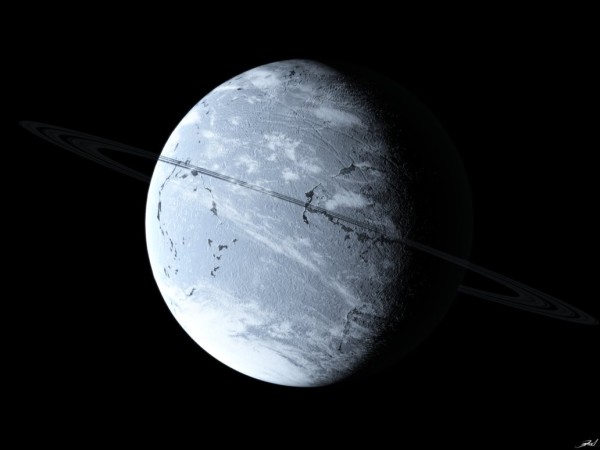 Image credit: ©2010–2015 daniellf of deviantART, via http://daniellf.deviantart.com/art/Frozen-Planet-Earth-173423844.
Image credit: ©2010–2015 daniellf of deviantART, via http://daniellf.deviantart.com/art/Frozen-Planet-Earth-173423844.
From Sinisa Lazarek on entropy and absolute zero: "If I have two baseballs, and one is hot and other cold. You are saying that the cold baseball has higher entropy then the hot one?! If you are tying it to thermals, shouldn’t it be the opposite? More heat, higher entropy… not more heat, lower entropy.. After all, at absolute 0, entropy is 0."
No. I'm saying that in a system like the Universe -- a huge, gigantic system -- uniformly low energies are your enemy from an entropy perspective. The "cooled" Universe is at lower entropy than the hot Universe, but that's also because it's more expanded and clumpier, not just because it is cooler. At absolute zero, entropy is 0 for an ideal gas, not for all systems. But let's go back to the baseballs, because that's where the real interesting things lie. And I'm going to assume, for the purposes of this exercise, that the two baseballs are the only things going on in this Universe.
If both of those baseballs are hot, you can't transfer any energy between them. You can't set some third "test particle" up on one of them and cause it to do anything useful. From a work point of view, you're out of luck. This is the same as if both of those baseballs are cold, or at absolute zero. In order to do work, you need a gradient. So what I'm saying, and I hope this is clearer, is that a lower entropy system has a heat source and a heat sink, or two reservoirs at different temperatures. A hot baseball and a cold baseball have lower entropy than two hot baseballs, if those "two baseball systems" are isolated systems. Does that make sense?
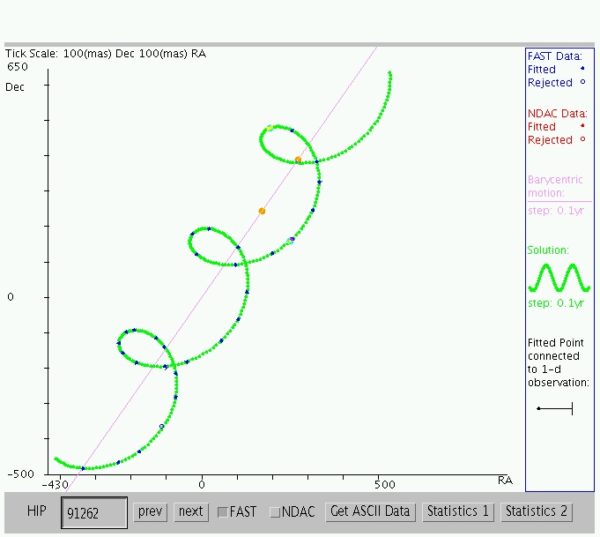 The "real" motion of Vega, just 26 light years away, as made from three years of Hipparcos data. Image credit: Michael Richmond of RIT, under a creative commons license, via http://spiff.rit.edu/classes/phys301/lectures/parallax/parallax.html.
The "real" motion of Vega, just 26 light years away, as made from three years of Hipparcos data. Image credit: Michael Richmond of RIT, under a creative commons license, via http://spiff.rit.edu/classes/phys301/lectures/parallax/parallax.html.
From Ciaran on very, very long baseline observations: "My first thought on seeing how messy that parallax data is why you’d only use one satellite.
Wouldn’t two on opposite sides of the earth’s orbit give you the full possible resolution of the telescope and take the proper motion out of the equation completely? Would that just be too expensive or is there another reason not to do that?"
From a practical point of view, what you're asking for is some very high-quality telescopes at differing locations around Earth's orbit. Because of how gravity works, there are only three locations that make sense if your goal is to create very long baselines with Earth: the L3, L4 and L5 Lagrange points.
There are no satellites, natural or artificial, around L3. It's an unstable Lagrange point, and getting there is much harder than getting to L1 or L2, which are also unstable. Because we can see and communicate with L1 and L2, and they're relatively close (a round-trip light signal is measured in seconds, rather than in half-hours), they're much easier to deal with. L3 is a mess.
But L4 and L5 aren't much better if precision is your goal. The only spacecraft we've ever sent there are NASA's Stereo-A and Stereo-B. Neither one made it to the Lagrange point and stayed there; they simply drifted through. And Stereo-B has been plagued by mission failures. In other words, it's a great idea, but we haven't had the right technical achievements to make this doable just yet. Getting to Hipparcos was a big deal; getting to Gaia is an even bigger one. But neither of those were NASA projects; I suppose perhaps the next big deal would be getting NASA to care about this problem.
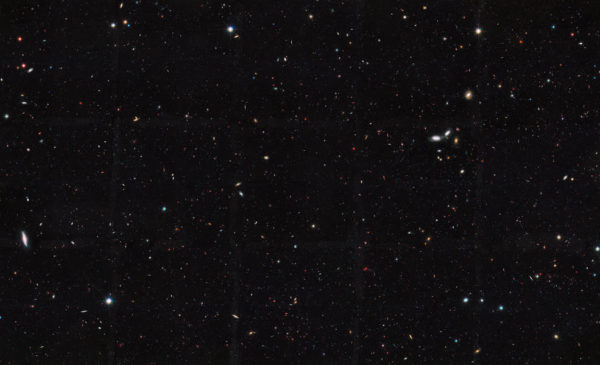 Image of the HST GOODS-South field, one of the deepest images of the sky but covering just one millionth of its total area. Image credit: NASA / ESA / The GOODS Team / M. Giavalisco (UMass., Amherst).
Image of the HST GOODS-South field, one of the deepest images of the sky but covering just one millionth of its total area. Image credit: NASA / ESA / The GOODS Team / M. Giavalisco (UMass., Amherst).
And finally, from Philip E Coleman on the trillions of galaxies in the Universe: "The never ending story that can never fully be explored"
Our knowledge of what's out there will always be fundamentally limited. First by what we're willing to invest, next by our technology, and finally, even if those two restrictions were removed, by the limited information the Universe provides us with. Even if we were able to collect every photon of every wavelength sent our way from every star, galaxy, nebula and more from now until the end of the Universe, the information we received would still be finite. There would still be mysteries the Universe didn't provide us with enough information to solve.
The key, in the time we have with the Universe we have, is to learn as much as possible and understand as much as we can. It's to ask the best questions and come as close as we can to answering them honestly and to the best of our abilities, while simultaneously being honest about the uncertainties and the unknowns. That is the great journey of science; that is the great journey of life.
Let's go a little further, together, with each and every moment, story and week that passes. I'll be here, and I hope you will, too.

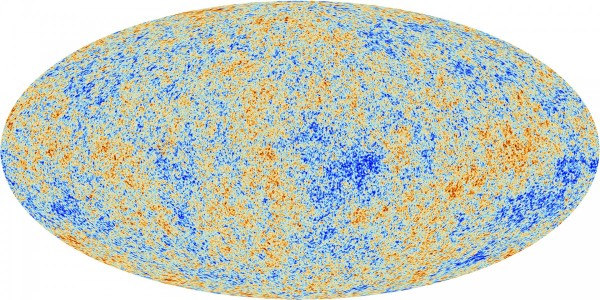

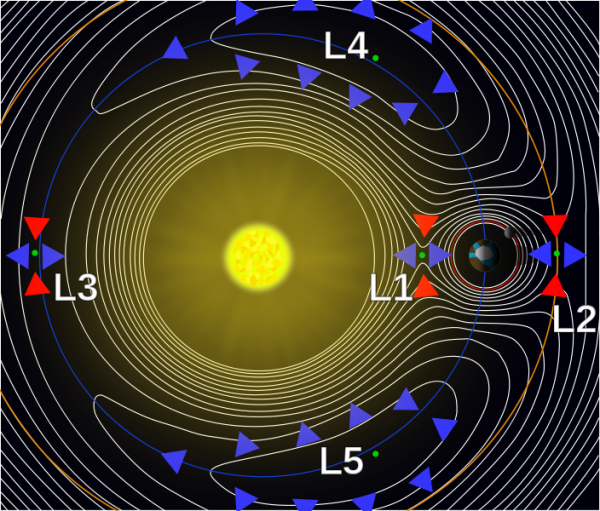
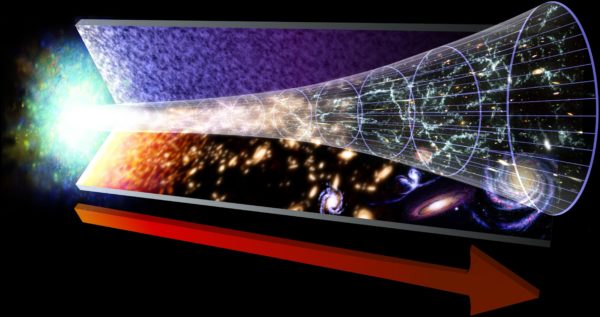
On August 28 2008 the stars flew one to another leaving a blank sky. Then the space ships came 1st 3 then more. I was abducted. We are not alone. I challenge you to bring to me an ibject. I can light it 4 you and it will tell you its story. I have been running frim man since 2008. Sherry
Ibject ?
Max cyclone energy. There is something like that in meteorology, hurricanes are heat engines taking the heat in the underlying ocean and dissipating it at the cloud tops. The maximum storm strength is limited by this ocean heat (and the finite coldness of the atmosphere several KM up. So a very long track won't allow a storm to surpass this value. Now the horizontal extent of a storm usually increases with time, so what one would expect from having a larger ocean, is similar max wind speeds (and lowest pressure), but possibly larger storms.
Now with hotter water, you can get stronger storms. Somewhere around 50C ocean temp, at least in theory there is a runaway effect, with a max speed greater than the speed of sound. These theoretical storms are called hypercanes, and they would have extreme environmental consequences.
When the coal fields on land were under water, the ocean covering them were large, shallow, and warm.
Perfect for building up MASSIVE hurricanes with huge windspeeds.
And, indeed, the average windspeed of hurricanes has been increasing due to AGW and the warming upper ocean.
Ethan has managed to confuse me a bit on entropy -
I never considered the case of absolute zero = zero entropy; in regards to the Universe, I think this is a non-sense proposition (like zero * infinity).
If the Universe can now be considered a closed system and the 2nd law of thermo is valid, then entropy is always increasing. Which means it will never reach absolute zero; instead it will get really cold, really uniformly, and just stay there forever.
Ethan says: "The “cooled” Universe is at lower entropy than the hot Universe, but that’s also because it’s more expanded and clumpier, not just because it is cooler."
So the transition from hot Universe to today must have DECREASED entropy. Second law violation there somehow.
Neat trick, if we can learn to duplicate it. As Asimov wrote in "The Last Question", "Let there be light!"
It depends on what definition you're using. Classically, dQ/T is undefined at T=0, sure. Under Boltzmann, things at T=0 are still going have a macrostate composed of more than one possible microstate.
I'm just guessing, but part of the problem here may be sloppy language. Most of the time physicists and chemists talk about entropy, they're really talking about delta S, not the absolute value of the quantity S. Delta S will go to zero as temperature decreases. S for various substances usually approaches 0 at T=0, but it doesn't have to equal 0, it just has to approach some constant value. That's one informal description of the third law of thermodynamics.
What you've said above is another informal description of the third law: no finite number of operations can get a system to absolute zero. However in practical terms the difference between a universe impossibly at T=0 and a universe close to that maximum, uniformly everywhere, may not be worth worrying about. After all, neither is going to have humans in it. :)
Someone else may have to explain the comments you quote here, I'm not sure I understand Ethan's point, and after several poor starts on writing down my guesses, I think the best thing to do is just let someone else weigh in here.
The comment from Ethan is eliding the necessary clause that the second law ONLY APPLIES TO IDEAL GASSES.
And the universe, working under the attractive force of gravity, does not constitute an ideal, or even near ideal, gas, which undergoes no long range forces and only short range repulsion.
Despite people being composed of many near identical objects interacting mostly at short range, we cannot apply ideal gas laws to social formations of humans.
Same with the galaxy.
eric, perhaps you're right that Ethan was talking about delta S.
Wow, it seems the second law is applied to lots of situations; I don't recall ever hearing "the second law of thermodynamics doesn't apply here."
I'm sure it's like Gaussian distributions - the rules work so well on the ideal system, we'll say others approximate the ideal and go from there.
But if we truly can't apply the second law to galaxies, the implications seem tremendous. So much so that I'm pretty skeptical.
Yet you remember me saying it to tell me you don't remember anyone saying it...???
Tell me, how does that work?
Does it work the same way as when you read my post to say you never heard it and also not read it saying WHY it doesn't apply here, to whit:
And the universe, working under the attractive force of gravity, does not constitute an ideal, or even near ideal, gas, which undergoes no long range forces and only short range repulsion.
Given the evidence of how little memory you have of events, why should we wonder at what you don't recall? Given your inability to remember things recently read, WHY are you skeptical of anything? The obvious thing to diffuse any skepticism you have of a claim is that you may not remember hearing the proof and accepting it.
Wow, way to take offense when none is intended!
When talking to someone and they hear "something is THIS way" and they reply, "I never heard that before" -
They mean they haven't heard it before the time immediately preceding. This is so common that I have to believe you just wanted to start some sort of insult contest.
I have no interest in that, so you win the contest by default.
"Wow, way to take offense when none is intended!"
No, Carl, YOU are taking offence. I'm insulting you. Do you comprehend what the difference is, dear?
But I guess when you've just been rhetorically pantsed in public, and you don't want to let go of your "skepticism" that makes you feel so special and superior to all those "egg heads" that have just studied the problems that you know intuitively the answer to, you really have to find something else to talk about in "response".
"They mean they haven’t heard it before..."
Either you've a huge ego, or you're pretending a massive community because you can't support your position from your own argument.
The difference between us is ***I THINK YOU CAN DO IT*** but *you* don't want to try, After all, thinking about it and finding you were wrong makes the world less understood and therefore more dangerous.
Be brave, look at the stupid claim you made and either support it with your own thoughts or reassess your argument and discard it when you see the problem. You don't get to pretend there's a crowd of people backing you without indicating you don't accept your own thinking processes.
*I* think they can do this.
And please reflect on whether ideal gas laws were developed with the understanding that there are long range forces at work or not. Because you're completely ignoring this absolute fact since it is devastating to your claim, and you just don't want that, you'd prefer to go off on emotional tangents (and, ironically, getti0ng the argument logic wrong there too).
D-. Could do better.
I'm happy to read in Ethan's subsequent Comments of the Week (#132) that there was a typo in his description of entropy in the Universe -
"I should have said higher, not lower. My mistake. An expanded, clumpier, cooler Universe has less ability to do work, and is in a higher entropy state." - Ethan, #132
That was the source of my confusion, and the subject of my post.
I'm so glad I didn't accept Wow's explanation.